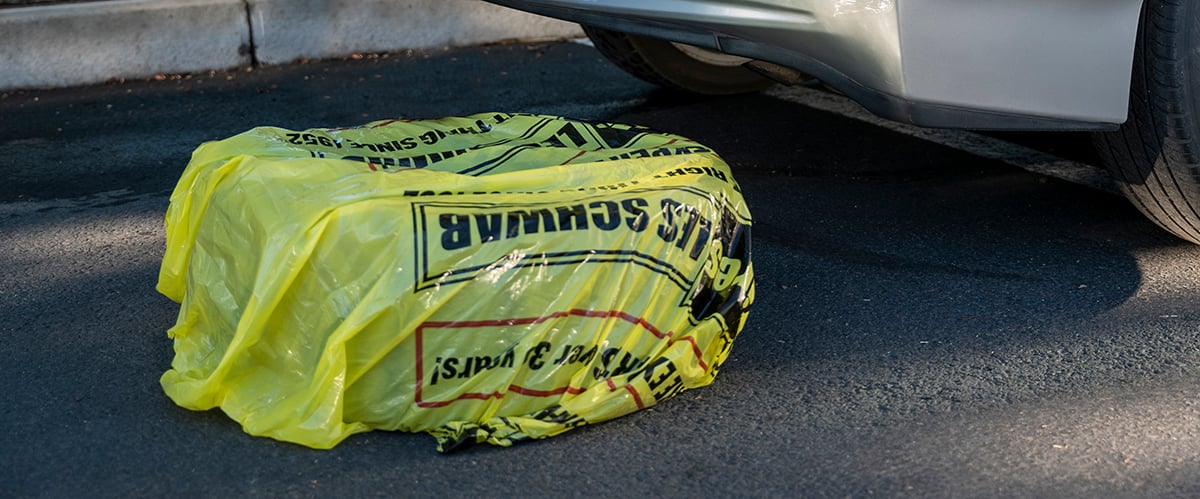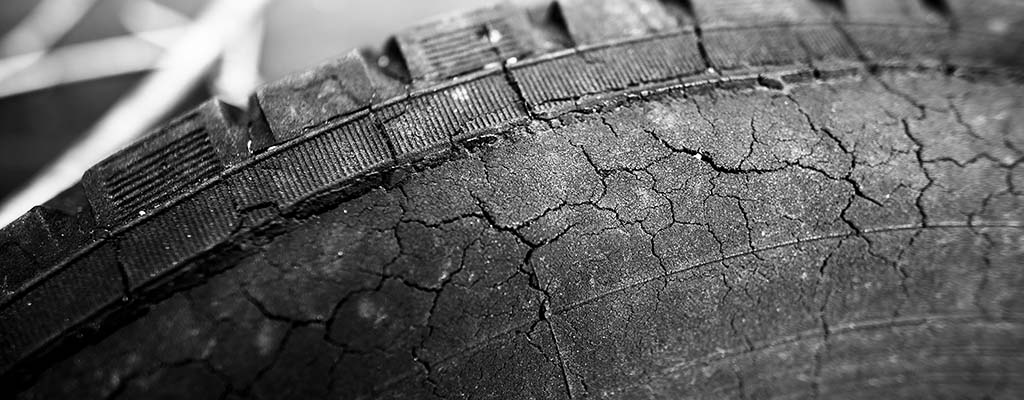Tire Dry Rot: Causes, Signs, and Prevention
Anytime you get behind the wheel, the tires on your vehicle directly impact your safety, fuel or range capacity, as well the overall performance of your car or truck. When those tires show signs of dry rot, it can cause them to lose air slowly, go flat quickly, or unexpectedly fail. Either way, it’s not a good thing. We have some information on tire dry rot, how to spot it, and what you can do to avoid it and get the most life out of your tires.
What is Tire Dry Rot?
You’ve probably heard of wood dry rot when the fibers in the wood break down and the whole thing becomes brittle. This is mostly due to contact with moisture and water. In contrast, tire dry rot is the development of cracks along a tire’s sidewall and tread, as well as rubber degradation and discoloration due to exposure to sunlight, heat, cold, and more. Extreme dry rot can almost feel crumbly when the tires are decades old or left exposed to the elements for years.
What Causes Tires to Dry Rot?
The causes of tire dry rot include age, weather, storage, as well as how and where you drive.
Age
There is no exact shelf life for a set of tires. Depending on how tires were stored and used, they could avoid dry rot for a very long time. But, as tires age, it becomes more likely that they will need to be replaced for safety reasons. Want to know when your tires were manufactured? Look for the letters DOT on the sidewall. The first set of four characters will be the Tire Identification Number, the next set will be the tire purpose, and the last set of four numbers will indicate the tire’s age. The first two digits indicate the week (01-52) and the next four digits indicate the year.
Weather
Heat and direct sunlight are some of the biggest causes of tire dry rot. Cold weather can play a role too, with freezing temperatures causing the rubber to get brittle. Together, the weather in your region can cause tires to wear out more quickly than expected.
Lack of Use
The average American vehicle is driven 15,000 miles a year. If you drive less, keep an eye on your tires. Especially if your vehicle stays parked outside of a garage (in the elements) for weeks or months on end.
Improper Storage
Even if you take the tires off an unused vehicle, the tires can age quickly when not stored properly. Learn how to store your tires properly with tips from Les Schwab.
Harsh Chemicals (Deicer)
Do you drive on maintained winter roads? You could be coming into contact with deicer. This chemical can damage tires over time. Additionally, some cleaning agents not designed for tires can cause damage over time.
Improper Air Pressure
Too much air in your tires can cause the rubber to separate over time. Additionally, too little air pressure can cause excessive heat which can cause the rubber to break down. Maintaining the proper air pressure can extend the life of your tires by up to 4,700 miles, according to the National Highway Traffic Safety Administration (NHTSA).
UV Light
Ultraviolet light can break down the rubber in your tires. There are some products that claim to provide your tires with a layer of protection from harmful UV light. Think of it as sunscreen for your tires.

Signs & Symptoms of A Dry-Rotted Tire
To detect dry rot on your tires, give thema quick inspection looking for some of the following symptoms. Or simply bring your vehicle by Les Schwab and we’ll give you a complimentary visual tire inspection.
Cracks on the Sidewall
You’ll see cracks and dry spots along the sidewall and under the tread.
Cracks on the Tread
Small cracks on the outside of the tire tread can be a serious sign of tire dry rot.
Fading Colors
A new tire should be dark in color. Tire dry rot can fade that color over time.
Low Air Pressure
If your tire pressure monitoring system is constantly telling you to add air to your tires, it could be a sign of tire dry rot.
Is it Safe to Drive on Dry Rotted Tires?
According to the NHTSA, there are 11,000 accidents every year due to faulty vehicle tires. Worse yet, those accidents claim lives. In 2021, 622 Americans lost their lives in tire-related incidents.
Essentially, no it is not safe to drive on dry rotted tires. Yes, there are degrees to the severity of the dry rot, but severely cracked sidewalls, inflexible tread, and rubber that may fall apart at any moment can be unsafe.
Ways to Prevent Tire Dry Rot
While it’s not always easy to spot tire dry rot, there are things you can do to extend the life of your tires.
Inspect Your Tires Regularly to Detect Early Signs of Dry Rot
Look for abnormal wear, cracks, fading colors, and any separation in the tread. The pros at Les Schwab can spot dry rot early and show you all of your options. Have your tires inspected at your local Les Schwab along with tire rotations every 5,000 miles.
Put Miles on Your Tires
Don’t just let your tires sit unused unless they are properly stored. Tires are meant to be driven on, so let them do their job to keep you and your family safe on the road.
Use the Garage or Tire Covers
If you have the option, park your vehicle in the garage or cover your tires with RV tire covers (if there is enough room in the wheel well). This can help protect your tires from excessive heat and cold, as well as UV light.
Clean Your Tires
Regularly using a special tire cleaner and protective agent every other time you wash your car can add life to your tires. Keep your tires looking like new with tire, wheel, auto body, and interior cleaning products at many Les Schwab locations.
Stay Safe with New Tires from Les Schwab
If the tires on your vehicle, RV, or trailer have been around for a while, or if you just aren’t sure if you’re seeing signs of tire dry rot, stop by your local Les Schwab. We’ll check them out and help you make the best decision for your safety and budget.

